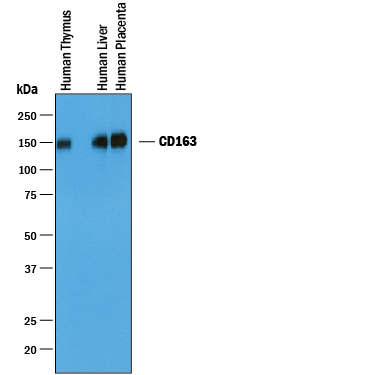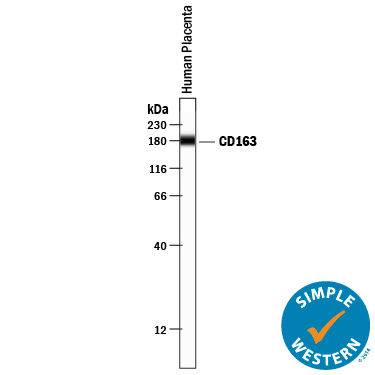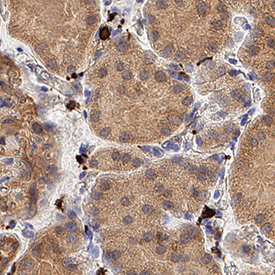Human CD163 Antibody Summary
Applications
Please Note: Optimal dilutions should be determined by each laboratory for each application. General Protocols are available in the Technical Information section on our website.
Scientific Data
 View Larger
View Larger
Detection of Human CD163 by Western Blot. Western blot shows lysates of human thymus tissue, human liver tissue, and human placenta tissue. PVDF membrane was probed with 1 µg/mL of Goat Anti-Human CD163 Antigen Affinity-purified Polyclonal Antibody (Catalog # AF1607) followed by HRP-conjugated Anti-Goat IgG Secondary Antibody (HAF019). A specific band was detected for CD163 at approximately 150 kDa (as indicated). This experiment was conducted under reducing conditions and using Immunoblot Buffer Group 1.
 View Larger
View Larger
Detection of Human CD163 by Simple WesternTM. Simple Western lane view shows lysates of human placenta tissue, loaded at 0.2 mg/mL. A specific band was detected for CD163 at approximately 179 kDa (as indicated) using 10 µg/mL of Goat Anti-Human CD163 Antigen Affinity-purified Polyclonal Antibody (Catalog # AF1607) followed by 1:50 dilution of HRP-conjugated Anti-Goat IgG Secondary Antibody (HAF109). This experiment was conducted under reducing conditions and using the 12‑230 kDa separation system.
 View Larger
View Larger
Detection of CD163 in Human Kidney. CD163 was detected in immersion fixed paraffin-embedded sections of Human Kidney using Goat Anti-Human CD163 Antigen Affinity-purified Polyclonal Antibody (Catalog # AF1607) at 5 µg/mL for 1 hour at room temperature followed by incubation with the Anti-Goat IgG VisUCyte™ HRP Polymer Antibody (Catalog # VC004). Before incubation with the primary antibody, tissue was subjected to heat-induced epitope retrieval using VisUCyte Antigen Retrieval Reagent-Basic (Catalog # VCTS021). Tissue was stained using DAB (brown) and counterstained with hematoxylin (blue). Specific staining was localized to fibroblasts. View our protocol for IHC Staining with VisUCyte HRP Polymer Detection Reagents.
Reconstitution Calculator
Preparation and Storage
- 12 months from date of receipt, -20 to -70 degreesC as supplied. 1 month, 2 to 8 degreesC under sterile conditions after reconstitution. 6 months, -20 to -70 degreesC under sterile conditions after reconstitution.
Background: CD163
CD163, previously called M130 or p155, is a 130-160 kDa type I transmembrane glycoprotein that belongs to group B of the cysteine-rich scavenger receptor family (1-3). It is essential for clearance of hemoglobin-haptoglobin (Hb-Hp) complexes in the liver, spleen and circulation (4). The human CD163 contains a 41 amino acid (aa) signal sequence, a 1009 aa extracellular domain (ECD) with 9 scavenger receptor cysteine-rich (SRCR) domains, a 22 aa transmembrane segment, and a 39-84 aa cytoplasmic region (1). The third SRCR domain is crucial for calcium-dependent binding of hemoglobin/haptoglobin complexes (3). Three splice forms (isoforms 2, 3 and 4) vary within their intracellular regions (1, 5), while one isoform (# 4) also has a 34 aa insert between SRCR domains 5 and 6 within the ECD. While all are expressed, isoform 3 is the most abundant, being generally expressed on the cell surface and most active in endocytosis (5). An approximately 130 kDa soluble form of human CD163 (sCD163) is assumed to contain virtually all of the ECD, which shares 74%, 75%, 84%, 86%, 86%, and 87% aa identity with mouse, rat, bovine, equine, porcine and canine CD163 ECD, respectively (6, 7). It is released from the cell surface by proteolysis after oxidative stress or inflammatory stimuli, including bacterial endotoxins and activation of the Toll-like receptors TLR2 or TLR5 (7 - 10). Expression of CD163 is constitutive, and induced by glucocorticoids, IL-10, IL-6 or endotoxin on circulating monocytes, tissue macrophages, and at low levels on monocyte-derived dendritic cells (1, 2, 11, 12). In addition to clearing Hb-Hp complexes, CD163 is also a scavenger receptor for free Hb (if Hp is depleted) and TWEAK (TNF-like weak inducer of apoptosis), and can function as an erythroblast adhesion receptor (4, 13-15).
- Law, S.K.A. et al. (1993) Eur. J. Immunol. 23:2320.
- Sulahian, T.H. et al. (2000) Cytokine 12:1312.
- Madsen, M. et al. (2004) J. Biol. Chem. 279:51561.
- Kristiansen, M. et al. (2001) Nature 409:198.
- Nielsen, M.J. et al. (2006) J. Leukoc. Biol. 79:837.
- Moller, H.J. et al. (2002) Blood 99:378.
- Droste, A. et al. (1999) Biochem. Biophys. Res. Commun. 256:110.
- Hintz, K. A. et al. (2002) J. Leukoc. Biol. 72:711.
- Weaver, L.K. et al. (2006) J. Leukoc. Biol. 80:26.
- Timmerman, M. and P. Hogger (2005) Free Radic. Biol. Med. 39:98.
- Buechler, C. et al. (2000) J. Leukoc. Biol. 67:97.
- Pulford, K.A. et al. (1989) J. Clin. Pathol. 42:414.
- Schaer, D.J. et al. (2006) Blood 107:373.
- Bover, L.C. et al. (2007) J. Immunol. 178:8183.
- Fabriek, B.O. et al. (2007) Blood 109:5223.
Product Datasheets
Citations for Human CD163 Antibody
R&D Systems personnel manually curate a database that contains references using R&D Systems products. The data collected includes not only links to publications in PubMed, but also provides information about sample types, species, and experimental conditions.
14
Citations: Showing 1 - 10
Filter your results:
Filter by:
-
A Single Amino Acid Substitution in Porcine Reproductive and Respiratory Syndrome Virus Glycoprotein 2 Significantly Impairs Its Infectivity in Macrophages
Authors: J Chaudhari, RA Leme, K Durazo-Mar, S Sillman, AM Workman, HLX Vu
Viruses, 2022-12-18;14(12):.
Species: Chlorocebus pygerythrus, Porcine
Sample Types: Whole Cells
Applications: Neutralization -
Development and Characterization of a cDNA-Launch Recombinant Simian Hemorrhagic Fever Virus Expressing Enhanced Green Fluorescent Protein: ORF 2b' Is Not Required for In Vitro Virus Replication
Authors: Y Cai, S Yu, Y Fang, L Bollinger, Y Li, M Lauck, EN Postnikova, S Mazur, RF Johnson, CL Finch, SR Radoshitzk, G Palacios, TC Friedrich, TL Goldberg, DH O'Connor, PB Jahrling, JH Kuhn
Viruses, 2021-04-07;13(4):.
Species: Primate - C. aethiops
Sample Types: Whole Cells
Applications: Neutralization -
Isolation and characterization of a new population of nasal surface macrophages and their susceptibility to PRRSV-1 subtype 1 (LV) and subtype 3 (Lena)
Authors: D Oh, J Xie, N Vanderheij, HJ Nauwynck
Vet. Res., 2020-02-24;51(1):21.
Species: Porcine
Sample Types: Whole Tissue
Applications: IHC -
Accumulation of stabilin-1 positive macrophages in the early stage of gastric cancer is associated with short cumulative survival
Authors: SP Yin, Y Gao, XS Xie, DD Xu, V Riabov, WD Du
Oncol Lett, 2020-01-16;19(3):2404-2412.
Species: Human
Sample Types: Whole Tissue
Applications: IF -
Preferential use of Siglec-1 or Siglec-10 by type 1 and type 2 PRRSV strains to infect PK15S1-CD163 and PK15S10-CD163 cells
Authors: J Xie, I Christiaen, B Yang, I Trus, B Devriendt, T Cui, R Wei, HJ Nauwynck
Vet. Res., 2018-07-18;49(1):67.
Species: Human, Porcine
Sample Types: Whole Cells
Applications: ICC -
Stabilin-1 is expressed in human breast cancer and supports tumor growth in mammary adenocarcinoma mouse model
Oncotarget, 2016-05-24;7(21):31097-110.
Species: Human
Sample Types: Whole Tissue
Applications: IHC-P -
Simian hemorrhagic fever virus cell entry is dependent on CD163 and uses a clathrin-mediated endocytosis-like pathway.
Authors: Cai Y, Postnikova E, Bernbaum J, Yu S, Mazur S, Deiuliis N, Radoshitzky S, Lackemeyer M, McCluskey A, Robinson P, Haucke V, Wahl-Jensen V, Bailey A, Lauck M, Friedrich T, O'Connor D, Goldberg T, Jahrling P, Kuhn J
J Virol, 2014-10-29;89(1):844-56.
Species: Primate - Chlorocebus aethiops (African Green Monkey)
Sample Types: Whole Cells
Applications: Neutralization -
CD163 and IgG codefend against cytotoxic hemoglobin via autocrine and paracrine mechanisms.
Authors: Subramanian K, Du R, Tan N, Ho B, Ding J
J Immunol, 2013-04-15;190(10):5267-78.
Species: Human
Sample Types: Cell Lysates, Whole Cells
Applications: Bioassay, Flow Cytometry, ICC, Western Blot -
Efficient clearance of early apoptotic cells by human macrophages requires M2c polarization and MerTK induction.
Authors: Zizzo G, Hilliard B, Monestier M, Cohen P
J Immunol, 2012-08-31;189(7):3508-20.
Species: Human
Sample Types: Whole Cells
Applications: ICC -
Interaction of the European genotype porcine reproductive and respiratory syndrome virus (PRRSV) with sialoadhesin (CD169/Siglec-1) inhibits alveolar macrophage phagocytosis.
Authors: De Baere MI, Van Gorp H, Delputte PL
Vet. Res., 2012-05-25;43(1):47.
Species: Porcine
Sample Types: Whole Cells
Applications: Neutralization -
Identification of the CD163 protein domains involved in infection of the porcine reproductive and respiratory syndrome virus.
Authors: Van Gorp H, Van Breedam W, Van Doorsselaere J, Delputte PL, Nauwynck HJ
J. Virol., 2009-12-23;84(6):3101-5.
Species: Porcine
Sample Types: Whole Cells
Applications: Western Blot -
Sialoadhesin and CD163 join forces during entry of the porcine reproductive and respiratory syndrome virus.
Authors: Van Gorp H, Van Breedam W, Delputte PL, Nauwynck HJ
J. Gen. Virol., 2008-12-01;89(0):2943-53.
Species: Porcine
Sample Types: Whole Cells
Applications: ICC, Neutralization -
Availability of activated CD4+ T cells dictates the level of viremia in naturally SIV-infected sooty mangabeys.
Authors: Klatt NR, Villinger F, Bostik P, Gordon SN, Pereira L, Engram JC, Mayne A, Dunham RM, Lawson B, Ratcliffe SJ, Sodora DL, Else J, Reimann K, Staprans SI, Haase AT, Estes JD, Silvestri G, Ansari AA
J. Clin. Invest., 2008-06-01;118(6):2039-49.
Species: Primate - Cercocebus torquatus (Sooty Mangabey)
Sample Types: Whole Tissue
Applications: IHC-P -
CD163 expression confers susceptibility to porcine reproductive and respiratory syndrome viruses.
Authors: Calvert JG, Slade DE, Shields SL, Jolie R, Mannan RM, Ankenbauer RG, Welch SK
J. Virol., 2007-05-09;81(14):7371-9.
Species: Primate - Macaca mulatta (Rhesus Macaque)
Sample Types: Whole Cells
Applications: Neutralization
FAQs
No product specific FAQs exist for this product, however you may
View all Antibody FAQsReviews for Human CD163 Antibody
Average Rating: 5 (Based on 1 Review)
Have you used Human CD163 Antibody?
Submit a review and receive an Amazon gift card.
$25/€18/£15/$25CAN/¥75 Yuan/¥2500 Yen for a review with an image
$10/€7/£6/$10 CAD/¥70 Yuan/¥1110 Yen for a review without an image
Filter by:



